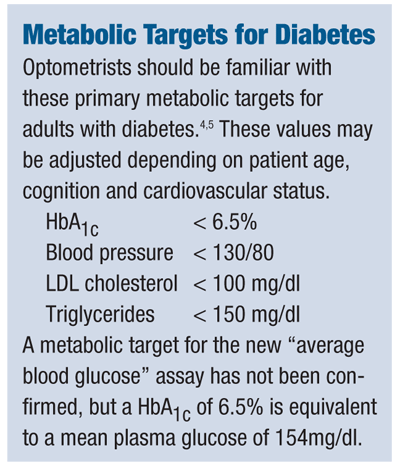 Q: I have a diabetic patient whom I dont think is under good glycemic control. Should I bypass his family practitioner and send him to an endocrinologist?
Q: I have a diabetic patient whom I dont think is under good glycemic control. Should I bypass his family practitioner and send him to an endocrinologist?
A: Diabetes represents a wonderful opportunity for doctors of optometry to partner with, and even educate, other physicians about our mutual patients, says A. Paul Chous, M.A., O.D., of Tacoma, Wash. Letting the primary-care practitioner (PCP) know that your patient has retinal microaneurysms (or worse) may be just the right impetus to initiate more aggressive blood glucose or blood pressure management. Looking at your patients glucose log book, measuring his blood glucose or HbA1c, measuring his blood pressure, knowing the metabolic targets, and directly communicating your concernsin combination with your ophthalmic findings and recommendationswill often positively influence the PCPs diabetes management plan.
Still, if a patient with diabetes continues to have poor metabolic control, Dr. Chouss next step is to educate the patient and explain the link between the risk of diabetes-related eye disease and poor diabetes control. If the patient is overwhelmed, I often recommend consultation with a certified diabetes educator to be coordinated by the PCP, he says. I then phone and/or write the family practitioner, explain my findings and my discussion with the patient, remind the PCP of appropriate metabolic targets, and ask for a note on any update to the treatment plan.
If the patient shows improvement, Dr. Chous congratulates him and the PCP. If not, he says, I try to tactfully but forcefully recommend an endocrine consultation.

Q: I heard that the A1C values are changing. What is the update on this, and how can I use these values to help comanage my patients?
A: Hemoglobin A1calso known as glycosylated hemoglobin, HbA1c or simply A1c has become the gold standard for assessing overall blood glucose control, says Dr. Chous, who has type 1 diabetes himself.
But, this standard is about to change.
The A1c assay was always assumed to reflect patients average blood sugar levels; but a direct, mathematical relationship between mean blood glucose and A1c was not established until 2002.1
Now, new research shows that this relationship is not linear, with increasing errors between the predicted and actual mean as the A1c level rises.2 To correct for this, a reference A1c method, which precisely measures glucose only, has been developed.3 This novel assay, called DOF hemoglobin, yields A1c values that are lower than current values. But, endocrinologists and patient advocates have voiced concern that this new standard will create even more confusion for patients and providers.
As a compromise, the new test will likely be called average blood glucose, and reported lab values will match units obtained by home blood glucose devices in mg/dl.
Hopefully, Dr. Chous says, adoption of the new standard (by mid-2008) will allow all health-care providers to better explain blood glucose control and, more importantly, recommend and implement more effective treatments before complications develop or worsen.
1. Rohlfing CL, Wiedmeyer HM, Little RR, et al. Defining the relationship between plasma glucose and HbA(1c): analysis of glucose profiles and HbA(1c) in the Diabetes Control and Complications Trial. Diabetes Care 2002 Feb;25(2):275-8.
2. Kilpatrick ES,
3. Jeppsson J, Kobold U, Barr J, et al. Approved IFCC reference method for the measurement of HbA1c in human blood. Clin Chem Lab Med 2002 Jan;40(1):78-89.
4. Lebovitz HE, Austin MM, Blonde L, et al; ACE/AACE Diabetes Recommendations Implementation Writing Committee. ACE/AACE consensus conference on the implementation of outpatient management of diabetes mellitus: consensus conference recommendations. Endocr Pract 2006 Jan-Feb;12 Suppl 1:6-12.
5. Expert Panel on Detection, Evaluation, and Treatment of High Blood Cholesterol in Adults. Executive summary of the third report of the National Cholesterol Education Program (NCEP) expert panel on detection, evaluation, and treatment of high blood cholesterol in adults (Adult Treatment Panel III). JAMA 2001 May 16;285(19):2486-97.

